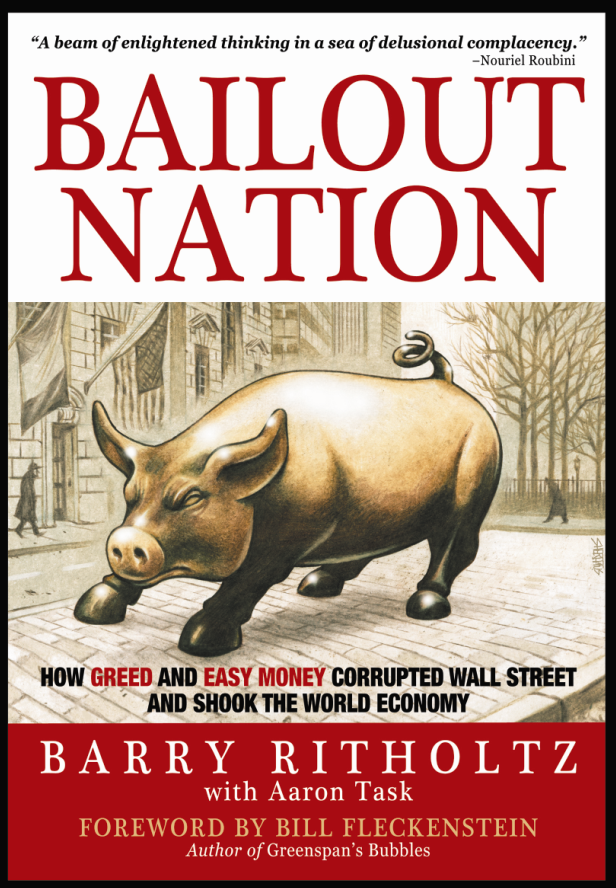 Tomorrow is the official publication date of Bailout Nation. This is the back story to how and why the book came to be.
Tomorrow is the official publication date of Bailout Nation. This is the back story to how and why the book came to be.
>
Long story short: After Bill Fleckenstein’s GREENSPAN’S BUBBLES was published, McGraw Hill asked him to do a follow up to that book.
He wisely said no.
However, Bill suggested they contact me.
Which they did. I turned the publisher down (several times). Who has time to write a book? Besides, I did not want to do a fast, rush-to-judgment type of thing. But they were tenacious in their pursuit, and I eventually succumbed to their flattery — on my terms, however, including having final edit on the manuscript. (This becomes important later on, as you will soon see).
Because of the way events played out, I ended up writing this beast three separate times. Literally: Bailout Nation was written as 3 complete books over 18 months.
The first version was a history of bailouts. I started playing with the idea of this back in October 2007. (We were short a lot of financial names then). By the Summer 2008, I had put together a broad overview covering the early 19th century, the history of the Fed, and a meaty arc from Lockheed (1971) to Bear Stearns (March 2008). It was a fairly pedestrian historical approach.
Around the time it was due (near Labor Day 2008), something funky was in the air . . . you could smell the leading edge of the approaching shitstorm. By the end of August 2008, I convinced the publisher to extend the deadline a few weeks.
Good thing I did . . . Boom! Fannie Mae blew up. Then Freddie Mac, Lehman Brothers, AIG, Citigroup, Bank of America. Soon Merrill was on the ropes, followed by Morgan Stanley, Goldman Sachs, GM and GE. All hell was breaking loose. Well, I thought, at least the book will be more interesting. The expanded version of the manuscript, with greater emphasis on the latter part of 2008, was finished in December ’08.
Or so I thought.
After I handed the book into the publisher (McGraw Hill), they let me know they had problems with my assessment of the Ratings Agencies. They were unhappy with my calling them “Pimps & Hos“, or describing their business model of rating junk bonds as AAA for big fees as “Payola.” (What else would you call it?)
Not coincidentally, McGraw Hill owns of the largest Rating Agencies, Standard & Poor’s.
My compromise was to change the tone — namely, to remove the reference to Pimps. However, in its place I was going to add publicly available data and congressional testimony, more detailed analysis, and quotations from experts. When it was finished, I found the revised section to be less vitriolic — but far more devastating to S&P. They (along with fellow rating agencies Moody’s and Fitch’s) were key enablers to the entire crisis. There were many other guilty parties, but I simply could not under-emphasize the ratings agencies.
When McGH rejected it again, I exercised my right to buy the manuscript back from them in January 2009 (I returned the advance). Numerous publishers were interested, but I went with Wiley — they have a great deal of experience publishing business/investing related books, and as a publisher, had no conflicts of interest that would interfere with telling the full story.
The third version was the charm.
By now, the amount of bailout money going to mismanaged companies, reckless speculators, and incompetent corporate executives had skyrocketed to 14 trillion dollars. This was infuriating to anyone paying attention.
Astonishing things happened as the book progresses. The more I researched and wrote, the more it was apparent we were witnessing the greatest heist ever made. By the last section of the book, history’s biggest transfer of wealth — from the taxpayer to the Banksters — was taking place. Trillions were being shifted from the responsible to the reckless, from the prudent to the incompetent. It was infuriating — and you will see as the book progresses my initial academic tone gets replaced with greater snark and anger.
I not only had my ending, I had a new cause — exposing those who caused this mess, be they Democrat or Republican, Corporate CEO or derivatives trader.
I hope the end result is something that will inform and illuminate, while entertaining you along the way . . .
>
~~~


What's been said:
Discussions found on the web: